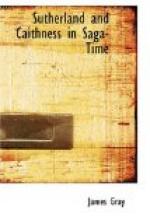CHAPTER V.
Paul and Erlend, Hakon and Magnus.
After Earl Thorfinn’s death his sons Paul and Erlend jointly held the jarldom, but divided the lands. They were “big men both, and handsome, but wise and modest"[1] like their Norse mother Ingibjorg, known as Earls’-mother, first cousin of Thora, queen of Norway, mother of King Olaf Kyrre.
On Thorfinn’s death, however, the rest of his territories, nine Scottish earldoms, it is said, “fell away, and went under those men who were territorially born to rule over them;” that is to say, they reverted to Scottish Maormors;[2] but Orkney and Shetland remained wholly Norse, and under Norse rule.
The date of the succession of Paul and Erlend to the Norse jarldom[3] was, as we have seen, after 1057. Possibly in 1059, or certainly not later than 1064 or 1065, Ingibjorg, Thorfinn’s widow, as by Norse law widows alone had the right to do, “gave herself away” to the Scot-King Malcolm III, known as Malcolm Canmore.[4]
As a matter of policy, the marriage was a wise step. For it would tend to strengthen not only the hold of Scotland on Caithness and Sutherland, but also its connection with Orkney and Shetland, because Ingibjorg’s sons, the young jarls Paul and Erlend, would become stepsons of the Scottish king and earls of Caithness. Nor was the marriage unsuitable in point either of the age or of the rank of the contracting parties. Married to Thorfinn about 1044,[5] Ingibjorg, his widow, need not in 1064 have been more than forty. She may have been younger, and Malcolm was, in 1064, about thirty-three. If the marriage was in 1059, Ingibjorg would be only thirty-five and Malcolm twenty-eight. That Ingibjorg was not old is proved by the fact that she had by Malcolm one son and possibly three sons,[6] namely, Duncan II, and, it may be, also Malcolm and Donald. As regards rank, also, she was equal to Malcolm, being a cousin of the Queen of Norway, and widow of Thorfinn grandson of Malcolm II, the great jarl of Orkney who had then recently subdued all the north of Scotland and the Western Isles and Galloway to himself, while Malcolm III was in exile in England, whence he had been brought back with the greatest difficulty, not by a Scottish force but by the help of an English, or at least a Northumbrian army.
After his marriage with Ingibjorg it is clear that there was peace for thirty years in the north of Scotland, so far as the Norse jarls were concerned, a fact which of itself justified the marriage, which, however, may have afterwards been held to have been within the prohibited degrees, and therefore void, while its issue would be held to be illegitimate, and not entitled to succeed to the Scottish crown.
We may add that there is nothing in any Scottish record to prove this marriage or to disprove it.




